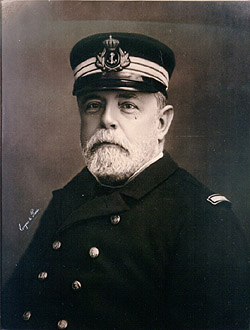Honor in Defeat
By William Sariego
June 2019
 Admiral Cervera, whose full name was Pascual Cervera y Topete, was the brave but doomed Spanish commander of the Caribbean Squadron that opposed the U.S. Navy during the Spanish-American War of 1898. Born on February 18th, 1839 in the municipality of Medina-Sidonia, this was the home of an even more famously doomed admiral in Spanish history, the commander of the infamous Armada of 1588. Admiral Cervera, whose full name was Pascual Cervera y Topete, was the brave but doomed Spanish commander of the Caribbean Squadron that opposed the U.S. Navy during the Spanish-American War of 1898. Born on February 18th, 1839 in the municipality of Medina-Sidonia, this was the home of an even more famously doomed admiral in Spanish history, the commander of the infamous Armada of 1588.
Cervera had a long and distinguished career in the navy beginning in 1852 when he enrolled at the San Fernando Naval Academy. He served well in the Moroccan campaign of 1859 and the 3rd Carlist War 1872-76, before resigning to serve as head of the Ministry of Marine. In this capacity he attempted to bring about a number of reforms to modernize and increase the efficiency of the Spanish fleet. Cervera attempted too much for overly conservative officers and some politicians, who fought him on many issues and whom refused to accept Spain’s fading colonial glory. Finally in 1896, fully disgusted with the political machinations in the government, he resigned.
 It is hard to keep a good man down, however, and with the powerful intercession of the Queen Regent he was recalled in 1898 as war with the United States loomed on the horizon. He was given the monumental task of reorganizing Spain’s fleet and trying to put it in some semblance of readiness for the defense of the crumbling empire. Speaking perfect English and having once been Naval Attache in Washington, he was the perfect man for the job. Time was needed and time was a luxury he did not have. It is hard to keep a good man down, however, and with the powerful intercession of the Queen Regent he was recalled in 1898 as war with the United States loomed on the horizon. He was given the monumental task of reorganizing Spain’s fleet and trying to put it in some semblance of readiness for the defense of the crumbling empire. Speaking perfect English and having once been Naval Attache in Washington, he was the perfect man for the job. Time was needed and time was a luxury he did not have.
Cervera was ordered to sail from Spain by the Ministry of Marine before his ships were ready, indeed the newest cruiser, the Cristobal Colon, set sail without her main armament installed! Admiral Cervera assembled his small fleet at Cape Verde, consisting of the Cristobal Colon, Almirante Oquenedo, Infante Marie Teresa, and the Vizcaya, along with three torpedo boats. Cervera believed using the Canary Islands as a base rather than risking blockade in Cuba was the best course of action, but was not permitted to execute this plan. By skillful sailing he was able to evade American ships searching for him and slip into Santiago harbor on May 19th. From there his freedom of maneuver was even more compromised because the Ministry of Marine subordinated his fleet under the command of the Governor-General of Cuba!
Confined to port by the close blockade of the powerful American battleships there was little for Admiral Cervera to do wait on events to unfold. Nearly two-thirds of his able-bodied seamen would go ashore and assist in the defense of Santiago as ground troops, leaving skeleton crews on the ships. Once he did get personally involved in action, helping rescue American sailors from the sunken collier Merrimac which had attempted to block the harbor channel. This act of chivalry did not pass unnoticed on either side of the Atlantic.
The demand for a sortie came from Madrid as early as June 23rd, but the admiral declined, fully knowing it would be suicidal to confront the American battleships. His one hope for a successful breakout was if bad weather could scatter the American ships. On July 2nd the direct order to sail was given by Governor-General Blanco and this could not be ignored. Sailors were recalled from shore duty and given the night to rest.

Glorious name, inglorious end: the wreck of the cruiser Maria Theresa.
The breakout attempt came Sunday morning, in the vain hope the American fleet would be caught unprepared as worship services neared. The Americans were alert enough however, and the Spanish ships succumbed one by one. The Colon almost escaped but had burnt all her good coal in the initial run and was overtaken by Oregon. In a “battle” between four armored cruisers and two destroyers versus four battleships, one armored and two auxiliary cruisers there could indeed be only one outcome.
In defeat Admiral Cervera’s humanity once more shown through. He expressed concern over the American sailors risking their lives heading into the flaming wrecks to help rescue survivors. Taken on board the Iowa, the admiral was saluted by his American captors as Marines presented arms. Held as a prisoner of war until September, he would return to Spain and face a court of inquiry over the battle. He was quickly cleared of any wrongdoing and retired to private life, passing away April 3rd, 1909. He is justly considered a hero today in Spanish history books.
Fight alongside this hero! Order Remember the Maine now.
Sign up for our newsletter right here. Your info will never be sold or transferred; we'll just use it to update you on new games and new offers.
|
